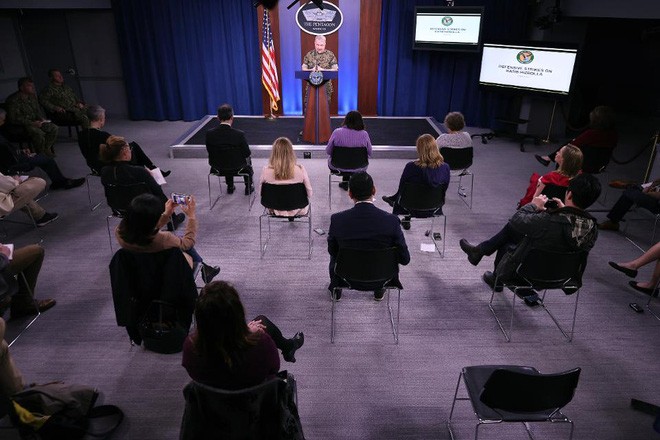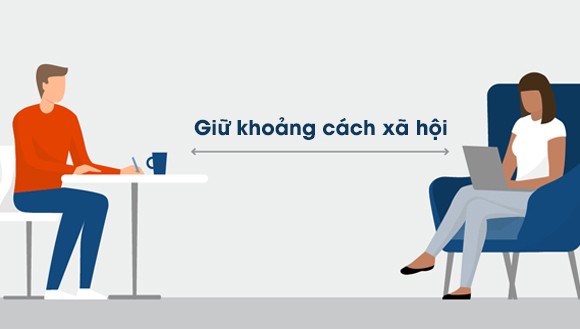The Math behind Covid-19 Translation: Why is it necessary to keep social distance, avoid gathering?
People and health officials in the US and Europe are trying their best to slow the spread of the Covid-19 epidemic. Measures of personal hygiene and social distance are being promoted.
Many mass gathering events have been canceled, including family gatherings. The school was temporarily closed, businesses moved to work online, people reduced the load of sightseeing activities, going to public places.
All of these are simple, powerful and effective strategies for disease control, in addition to testing and quarantining infected and at-risk patients.
 The Math behind Covid-19 Translation: Why is it necessary to keep social distance, avoid gathering? Picture 1
The Math behind Covid-19 Translation: Why is it necessary to keep social distance, avoid gathering? Picture 1  The Math behind Covid-19 Translation: Why is it necessary to keep social distance, avoid gathering? Picture 2
The Math behind Covid-19 Translation: Why is it necessary to keep social distance, avoid gathering? Picture 2 Epidemiologists say all measures to prevent the spread of Covid-19 must be taken in the early stages of an outbreak, when fewer people are infected and most patients will be saved. living.
On the contrary, as the disease has spread and become more dangerous, many interventions may become too late. That's what some countries like China and Italy have experienced, when it seems that overnight, the number of infections and deaths from Covid-19 has increased dramatically.
For the virulent plague epidemic outbreak, it is a fact that will take place. By the cause of a horrific night with this steep graph line can be explained mathematically.
The mathematics behind the plague
Right now, many countries around the world are witnessing the spread of Covid-19 which is exponentially growing. This is when the spread of an infectious disease is proportional to the number of people infected.
Each person infected with Covid-19 is expected to infect a certain number of people. This number is called the basic transmission coefficient R0, now valued at about 2.5.
On average, each person infected with Covid-19 will therefore infect more than 2 people, unless drastic measures are taken to reduce social exposure and quarantine the infected person.
Think of a sequence of numbers multiplied by 2: 1, 2, 4, 8, 16, etc. How many times will you have to count to cross the 1 million mark? It turned out to be only 20 times. And how many steps will it take to surpass 16 million? Only 4 more times.
 The Math behind Covid-19 Translation: Why is it necessary to keep social distance, avoid gathering? Picture 3
The Math behind Covid-19 Translation: Why is it necessary to keep social distance, avoid gathering? Picture 3  The Math behind Covid-19 Translation: Why is it necessary to keep social distance, avoid gathering? Picture 4
The Math behind Covid-19 Translation: Why is it necessary to keep social distance, avoid gathering? Picture 4 Exponentially is the reason why you get the feeling that Covid-19 initially spread very slowly, creating a subjective feeling, but at some point, it seems like it will flare up horribly.
As epidemiologist Adam Kucharski pointed out on his Twitter page, this trend also shows the importance of reducing infection rates at an early stage of the epidemic.
" When the disease broke out, on average, each person infected with Covid-19 would infect about 2.5 other people. On average, about 5 days of incubation for the next case to appear. So we estimate There will be 2.5 ^ 6 = 244 infections after only one month.
But if we could cut the transmission coefficient in half, each person would then infect only 1.25 others, we would only have 4 new infections in the same period . "
And individual actions can make a big difference. Reuters said a Covid-19 patient in South Korea, called Patient No. 31, did not adhere to the principles of social distance.
While having symptoms of Covid-19 infection, this person was in direct contact with 1,160 others and created terrible clusters of infection. The lesson here is not to be like Patient No. 31. If you have symptoms of fever, cough, shortness of breath, isolate yourself at home to protect loved ones and the whole society.
Flatten the curve
Of course, mathematically speaking, Covid-19 cannot spread exponentially forever. There is an upper limit to the population and over time, people begin to build immunity to the disease, and the infected people begin to recover creating a community immunity effect and the number will be slow. again.
As with many other epidemics in the past, it is likely that we will reach a peak in Covid-19, after which, new infections will begin to diminish until R0 drops below 1 and the epidemic will be suppressed.
However, the important thing we need to do is to combine all the measures to smooth this curve, spread new cases in as long as possible.
This will buy valuable time for hospitals and health systems, allowing them to turn around limited resources such as patient beds, ventilators and even human resources to treat Covid-19 infected patients. .
 The Math behind Covid-19 Translation: Why is it necessary to keep social distance, avoid gathering? Picture 5
The Math behind Covid-19 Translation: Why is it necessary to keep social distance, avoid gathering? Picture 5  The Math behind Covid-19 Translation: Why is it necessary to keep social distance, avoid gathering? Picture 6
The Math behind Covid-19 Translation: Why is it necessary to keep social distance, avoid gathering? Picture 6 Taking drastic measures to limit the transmission rate of Covid-19, including school closures, canceling public events and working online seems an overreaction to the number of cases. Infections in a city or state are few. However, it is the most effective measure during the early outbreak of the disease.
Using data from Hubei Province, China, where the Covid-19 virus originated and spread and the majority of the cases in China, author Tomas Pueyo posted on Medium a conceptual model. which he created, showing that even one day of implementing social distance-keeping measures could reduce the burden of new Covid-19 infections on the health system:
 The Math behind Covid-19 Translation: Why is it necessary to keep social distance, avoid gathering? Picture 7
The Math behind Covid-19 Translation: Why is it necessary to keep social distance, avoid gathering? Picture 7 According to an estimate published in the New York Times, the highest number of cases in the United States can reach 9.4 million if disease intervention measures are not implemented. But with these measures starting to take off today, the cumulative peak can be reduced to 3 million.
In short, interventions to prevent diseases need to be started as soon as possible. It was the golden time we had before the huge numbers came out.
* What should you do when exposed to the risk of a Covid-19 infection caused by the new SARS-CoV-2 virus? Take the following quiz to check:
Refer to Vox
You should read it
- [Infographic] 13 false rumors about corona virus: WHO explains why they are all unscientific
- Research from 3 scientists: 40 measures to combat Covid-19 in a timely, effective manner, to stop epidemic peaks, not to cause hospital overload
- How to disinfect clothes at home to prevent the Covid-19 epidemic
- Using 3D printing equipment, a breathing machine in the US can serve up to 4 Covid-19 patients in an emergency.
- New York University shared a sample of the Covid-19 room visor, which everyone can make at home
- How are scientists knowing whether the Covid-19 patients recover and become infected again?
- Experts answer: can Covid-19 pathogens get into clothing, shoes when on the road?
- Video: Lessons from the isolated life because of Covid-19 of people around the world
- Covid-19 Room: Don't forget to dry your hands if you don't want your hands to become rubbish
- Prestigious research completely rejects the conspiracy theory that Covid-19 is a 'born from the laboratory' biological weapon.
- Please download the free Covid-19 icon set for the design
- This AI 'doctor' is being used to quickly diagnose Corona virus
May be interested

What is Blogger?

5 benefits of using a helmet with goggles not everyone knows

Beautiful 3-storey villa model

Disney stars suggest how to avoid Covid-19: Instead of shaking hands, let's greet each other like 'Wakanda Forever'

The United States first tested Covid-19 vaccine on humans today

The story of the driver nearly a month stuck in the middle of the Chinese highways during the Covid-19 epidemic






 'Terminator' Arnold Schwarzenegger isolating himself at home with his pet to avoid Covid-19, and also a video that teaches the 'boss' how to wash their hands properly
'Terminator' Arnold Schwarzenegger isolating himself at home with his pet to avoid Covid-19, and also a video that teaches the 'boss' how to wash their hands properly The young man drones take his dog for a walk to avoid Covid-19
The young man drones take his dog for a walk to avoid Covid-19 Singaporeans must go to jail if keeping a distance of less than 1 m in Covid-19
Singaporeans must go to jail if keeping a distance of less than 1 m in Covid-19 Official iOS 13.5: COVID-19 exposure detection, easier to unlock iPhone when wearing a mask
Official iOS 13.5: COVID-19 exposure detection, easier to unlock iPhone when wearing a mask Why is 'letting Covid-19 spread to create community immunity' is an extremely dangerous view?
Why is 'letting Covid-19 spread to create community immunity' is an extremely dangerous view?